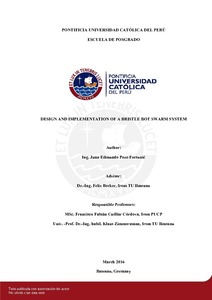| dc.contributor.advisor | Becker, Felix | es_ES |
| dc.contributor.author | Pozo Fortunić, Juan Edmundo | es_ES |
| dc.date.accessioned | 2017-02-06T23:47:44Z | es_ES |
| dc.date.available | 2017-02-06T23:47:44Z | es_ES |
| dc.date.created | 2016 | es_ES |
| dc.date.issued | 2017-02-06 | es_ES |
| dc.identifier.uri | http://hdl.handle.net/20.500.12404/7686 | |
| dc.description.abstract | Swarm robotics focuses on the study and development of robot systems containing a large number of agents that interact with each other in a collective behaviour in order to achieve tasks or overcome obstacles. Bristlebots are vibration-driven mobile robots. They are characterized by small size, high speed, simple design and low costs for production and application – qualities which are advantageous for agents of swarm robotic systems. However, most studies have been developed over systems with no control or systems with two or more actuators.
The aim of this master thesis is the development of a bristle based robot agent for a swarm robotics microsystem with units for locomotion, sensing, data processing, control, communication and energy storage. New approaches in modelling and development of swarm agents are given, and a robot prototype is presented. The robot is driven by a single DC motor and uses a bristle system to create locomotion. It should be noted, that within the system design, considerations for the size, weight and minimalist architecture are taken.
Experiments are presented and the system’s capabilities for displacement, velocity and trajectory generation are analysed. While the parallel velocity maintains a positive magnitude in both motor rotation directions, the rotation speed and transversal velocity of the robot have opposite directions, creating curved trajectories with opposite orientations. In Frequencies up to 210 Hz, the rotation direction of the robot is maintained while the magnitude slightly varies. However, for higher frequencies, the rotation direction of the robot is reversed, maintaining a similar magnitude. The transversal speeds at this frequency range, maintain their direction but are clearly reduced compared to lower frequencies. | es_ES |
| dc.description.uri | Tesis | es_ES |
| dc.language.iso | eng | es_ES |
| dc.publisher | Pontificia Universidad Católica del Perú | es_ES |
| dc.rights | info:eu-repo/semantics/openAccess | es_ES |
| dc.rights.uri | http://creativecommons.org/licenses/by-nc-nd/2.5/pe/ | * |
| dc.subject | Robots móviles | es_ES |
| dc.subject | Inteligencia de enjambre | es_ES |
| dc.subject | Robótica | es_ES |
| dc.title | Design and implementation of a bristle bot swarm system | es_ES |
| dc.type | info:eu-repo/semantics/masterThesis | es_ES |
| thesis.degree.name | Maestro en Ingeniería Mecatrónica | es_ES |
| thesis.degree.level | Maestría | es_ES |
| thesis.degree.grantor | Pontificia Universidad Católica del Perú. Escuela de Posgrado | es_ES |
| thesis.degree.discipline | Ingeniería Mecatrónica | es_ES |
| renati.discipline | 713167 | es_ES |
| renati.level | https://purl.org/pe-repo/renati/level#maestro | es_ES |
| renati.type | http://purl.org/pe-repo/renati/type#tesis | es_ES |
| dc.publisher.country | PE | es_ES |
| dc.subject.ocde | https://purl.org/pe-repo/ocde/ford#2.00.00 | es_ES |






